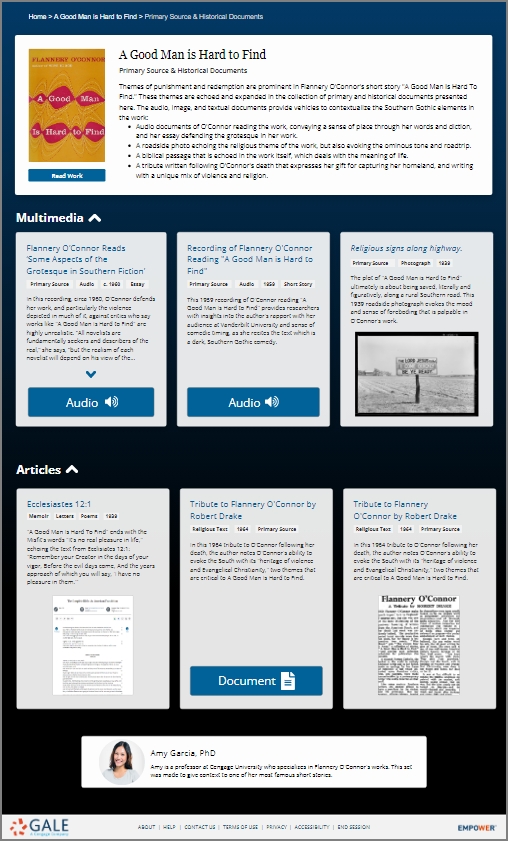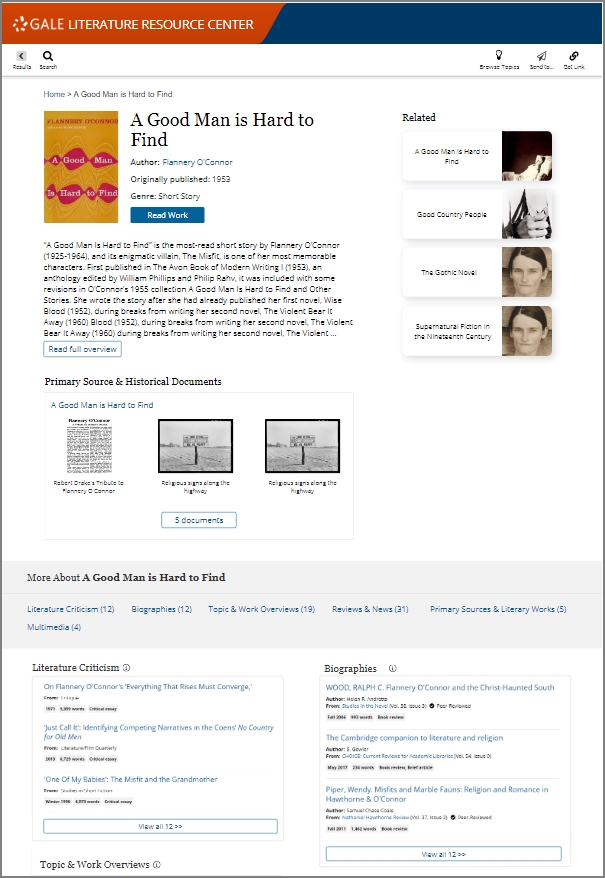| By Gale Staff |
We’re excited to announce that Gale Literature Resource Center will be receiving enhancements aimed to expand classroom use for both students and instructors. Students will be able to quickly find useful content—even for those less familiar with primary sources. Instructors will find easy-to-use selections of primary source documents that can boost student engagement and classroom discussions.
About the Enhancements
What’s Being Added?
- Topic Portals: We’ll be adding portal and topic pages for Works and Literary Topics/Themes. This will provide you with comprehensive information and resources on various literary works and their associated themes.
- Browse Functionality: Our new browse functionality will make it easier for you to navigate and explore the vast collection of content available on our platform. You’ll be able to discover works, topics, and themes of interest with just a few clicks.
- Access to Original Works of Literature: We’re thrilled to offer access to original works of literature, powered by the Gale College Collection. You’ll have the opportunity to engage with a wide range of literary masterpieces and explore the rich world of literature.
- New Primary Source and Historical Document Sets: We’ll be including new sets of primary and historical documents for select Work portal pages. These collections of materials, comprising videos, audio, and textual documents, will provide valuable resources for instruction and research purposes.
What’s Being Changed?
To enhance the user experience and streamline the platform, we will be removing the following:
- Current Featured Works & Authors browse pages: We’re focusing on providing a portal experience that will better support user needs. By focusing on Works and Literary Topics/Themes, we can cater to the most-common use cases for our users. No content is being removed, and it will still be accessible via search.
These changes are designed to provide you with a more comprehensive and user-friendly platform. With over 700 portal pages, more than 160 works, over 500 literary topics and themes, access to new original works of literature, and inclusion of primary source and historical document sets, we aim to support your research, learning, and engagement with Gale Literature Resource Center.
Enhancement Release Information
This enhancement will roll out in two phases:
| Phase 1 | Phase 2 |
| Release: July 28, 2023 | Release: early 2024 |
| – Browse functionality – 169 new Work portals at release – 270+ new Topic portals at release (500+ by end of August) – Access to 100+ original works of literature | Addition of Primary Source and Historical Documents sets, building to 100 distinct sets comprised of 500+ documents |
The July 28 release marks the beginning of these exciting enhancements, with the majority of new portals and content expected to be added in early fall. The enhancements will automatically take effect; current customers do not have to take any action.
We look forward to providing you with a robust and immersive literary resource.
Get an Inside Look at the User Research
By Cara Suriyamongkol, User Experience Designer
Gale Literature Resource Center has always had a deep and wide array of valuable documents and resources for those conducting literary research—from a first-year student working on one of their first college essays to a Ph.D. candidate preparing their thesis.
But when I started on the project last year, the team had identified an opportunity to improve some of our users’ experience in Gale Literature Resource Center—mainly our undergraduates who were just starting to familiarize themselves with academic databases. This led to the start of a user-centered enhancement project that went through multiple rounds of ideation, design, research, and iteration, and lasted approximately eight months.
We started with a hypothesis that undergraduate students who were less experienced in research needed a way to scan and organize our resources to quickly find primary and historical documents associated with the literary works they’re studying and researching. This required designing at least two new types of pages for Gale Literature Resource Center, the Primary Source & Historical Documents page and the Topic portals.

As both of these pages were new, I worked on designing a variety of solutions, approaching the challenge from multiple standpoints. We were able to lean on some preexisting work from other Gale products for our Topic portals, but the Primary Source & Historical Documents page would be new from the ground up. For that, I developed at least four different solutions that generally fit into a loose spectrum—the simplest designs focused on scannable text and the ability to “jump out” to view a specific document in depth, while the more complex designs were akin to a slide deck, carefully walking students through a set of documents they would read or view one by one.
The next step was putting the designs in front of our users. We set up a series of interviews focused on uncovering how the users would fit the different solutions into their current workflows and checked to ensure they were aligning with the users’ needs. Questions for our users included how educators or students might use these pages in or after class, if there were questions or concerns that came to mind, and we did usability testing to make sure they could find the different types of information and links on the pages.

The research portion of the project lasted three rounds and at least six months, and after each round of research—or sometimes after a single conversation—I would make changes to the designs such as wording changes, repositioning elements, or scrapping a design option if I could see it wasn’t meeting the users’ expectations or was causing users to struggle with page navigation.
Eventually we were able to narrow down the different solutions to one improved design. We presented the design to our engineering and content teams to ensure what we were designing was feasible from their standpoint, and to dig into some of the edge cases to make sure we were taking them all into consideration.
What’s exciting about the process is that each of the new pages and features we’re releasing with the new Gale Literature Resource Center enhancements were made alongside our users each step of the way. If it’s any indication, looking back I have dozens of previous designs for these projects, multiple pages of research notes, and hours of interviews and usability tests. Due to the iterative process, I was able to see an incremental increase in understanding and excitement after each round of research and design changes, which makes me confident these changes are going to delight our students, librarians and educators—and hopefully make life a little easier for them too.
Watch our webinar Literature Resource Center Enhancements to Bolster Higher Ed Research Opportunities to take a tour of the all-new browse functionality, 700+ portal pages focused on works of literature and literary topics, new primary and historical document sets, plus access to an additional 100+ original works of literature.
For more support, visit our support site or reach out to your sales rep.


